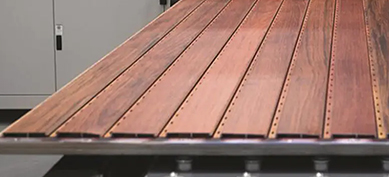Introduction to Core Construction in wpc fence panels
When selecting materials for a fencing project, professionals and wholesalers must make informed decisions based on a deep understanding of product characteristics. Among the various specifications for wpc fence panels, the internal core construction—whether hollow or solid—represents a fundamental differentiator. This aspect of design is not merely a manufacturing detail but a critical factor that influences performance, cost, application suitability, and long-term value. A hollow core design typically features a multi-chambered, grid-like internal structure, while a solid core is, as the name implies, uniformly dense throughout the profile. The choice between them extends far beyond simple weight or cost considerations; it impacts the very integrity and functionality of the installation.
The Fundamental Design and Structure
The architectural principle behind the core of a wpc fence panel is a primary driver of its physical properties. While both types share a common material base of wood plastic composite, their internal geometries are engineered to achieve different performance goals.
Hollow Core Design and Engineering
Hollow core wpc fence panels are characterized by an internal structure that incorporates a series of longitudinal chambers or channels. This is not a single, large empty space but a carefully engineered network of ribs and webs that create a rigid, box-like section. The principle is analogous to structural engineering concepts used in steel I-beams, where material is strategically distributed to the areas of highest stress to maximize strength-to-weight ratio. This design results in a panel that is significantly lighter than its solid counterpart. The reduction in material usage is a direct consequence of this hollow structure, which has immediate implications for production costs and logistical handling. The chambers can also contribute to improved thermal insulation properties and can help in preventing the accumulation of moisture within the core by allowing for air circulation, provided the ends are properly sealed.
Solid Core Design and Engineering
In contrast, solid core wpc fence panels are manufactured with a complete, unbroken infusion of the composite material throughout the entire profile. This results in a product of substantial density and mass. The manufacturing process for a solid core requires a greater volume of raw materials—wood fibers and polymers—to fill the extrusion die completely. This inherent density is the source of its most notable characteristics: a profound sense of robustness and a high moment of inertia, which translates to superior resistance against bending forces. The feel and sound of a solid core panel, often described as a dull, non-hollow “thud” when tapped, communicate a perception of premium quality and permanence. The lack of internal voids eliminates potential pathways for moisture or pests, creating a monolithic barrier, although proper formulation remains critical to prevent water ingress through the material itself.
Comparative Analysis: Key Performance Factors
To make an informed choice between hollow and solid core wpc fence panels, it is necessary to evaluate their performance across several key criteria. The following table provides a high-level overview, with a more detailed discussion below.
| Performance Factor | Hollow Core WPC Fence Panels | Solid Core WPC Fence Panels |
|---|---|---|
| Structural Strength & Impact Resistance | Good rigidity for most residential uses; more susceptible to impact damage. | Superior strength and rigidity; high resistance to impact and heavy loads. |
| Weight & Ease of Installation | Significantly lighter, easier to handle and install; may require more posts in high-wind areas. | Heavy and substantial, requiring more labor; provides inherent stability. |
| Durability & Longevity | Highly durable with proper formulation; chamber design requires end-capping to prevent water ingress. | Excellent long-term durability; monolithic structure is inherently resilient. |
| Cost-Effectiveness | Lower material cost per panel; reduced shipping and handling costs. | Higher initial investment; perceived higher value can justify the cost. |
| Acoustic & Insulation Properties | Chambers can dampen sound and provide slight thermal insulation. | Dense mass provides superior sound blocking and a feeling of substantiality. |
Structural Integrity and Load-Bearing Capacity
The structural performance of a wpc fence panel is a primary concern for commercial projects and installations in areas prone to high winds or potential impact. Solid core panels possess a clear advantage in this domain. Their uniform density allows them to distribute stress evenly across the entire profile, granting them exceptional resistance to bending and brute force. This makes them the preferred choice for applications where security or containing large animals is a factor. Hollow core panels, while engineered for rigidity, derive their strength from the external walls and internal webbing. They perform admirably in standard residential privacy fencing applications but may be more vulnerable to cracking or permanent deformation if subjected to a significant concentrated impact. For wholesalers, understanding the typical applications of their clientele is key; selling solid core panels into the high-security fencing market and hollow core into general residential markets aligns product capability with user need.
Weight and Implications for Installation
The difference in weight between the two core types is one of the most immediately apparent practical distinctions. Hollow core wpc fence panels offer a distinct advantage in terms of handling and logistics. Their lighter weight makes them easier for a small crew or even a single installer to maneuver, potentially reducing labor time and costs. This also translates to lower shipping costs for distributors and wholesalers, a critical factor in cost-effective procurement. Conversely, the substantial weight of solid core panels contributes to their stability but also makes them more cumbersome to install. They often require a more robust supporting structure, including heavier-gauge posts and potentially more concrete for footings, to adequately support their mass. This is a crucial consideration for fence installers when quoting projects, as the foundation requirements can differ significantly.
Long-Term Durability and Weather Resistance
Both types of wpc fence panels are designed to be highly durable and resistant to rot, decay, and insect infestation, outperforming traditional wood. However, nuances exist in their long-term performance. For hollow core panels, the primary consideration is the management of the internal chambers. If the ends of the panels are not properly sealed or capped, these chambers can potentially trap moisture, which, in freezing climates, could lead to internal ice formation and damage. High-quality manufacturing addresses this through integrated end caps or sealants. The solid core, with its lack of voids, presents no such internal cavity for moisture to accumulate, making it inherently robust against such environmental challenges. Both types must be formulated correctly to resist UV degradation and moisture absorption through the composite material itself, but the solid core’s monolithic nature provides a straightforward path to long-term weather resistance.
Cost and Value Considerations
From a procurement and sales perspective, cost is a driving factor. Hollow core wpc fence panels are generally more cost-effective to produce due to lower raw material consumption. This saving is passed down the supply chain, resulting in a lower price point for wholesalers and end-users. This makes them an excellent choice for large-scale residential developments or projects with stricter budgets. Solid core panels command a higher price due to the increased material usage and the perception of a premium, high-end product. For the buyer, this higher initial investment is often justified by the product’s superior feel, acoustic properties, and unmatched sense of security and permanence. Wholesalers should position solid core panels as a premium offering for clients seeking the highest quality in luxury fencing projects, where the value is perceived in the product’s performance and aesthetics, not just its unit cost.
Application-Specific Recommendations
Choosing between hollow and solid core wpc fence panels is not about identifying a universally superior product, but rather about matching the product’s inherent strengths to the specific demands of the application.
Ideal Applications for Hollow Core WPC Fence Panels
The lightweight and cost-efficient nature of hollow core panels makes them exceptionally well-suited for a wide range of standard residential and commercial uses. They are an ideal solution for residential privacy fences in suburban settings, where their primary function is to define property lines and provide visual screening. Their ease of handling makes them a favorite among DIY enthusiasts and installation crews working on large tracts of land where transporting heavy materials is impractical. For decorative fencing where intricate styles and patterns are desired, the lighter weight can be a significant advantage. They are also a practical choice for projects where budget is a primary constraint without a significant sacrifice in durability or aesthetic appeal. Wholesalers will find that hollow core panels often represent their highest volume sellers for the general consumer market.
Ideal Applications for Solid Core WPC Fence Panels
Solid core wpc fence panels excel in applications where performance, security, and a premium aesthetic are non-negotiable. They are the definitive choice for security fencing around high-value commercial properties, industrial sites, and facilities requiring a robust physical barrier. Their mass and density make them exceptionally difficult to breach, providing a level of security that hollow core panels cannot match. This same characteristic makes them ideal for pet containment for strong or large animals, where impact resistance is paramount. In upscale residential areas or for luxury property developments, the substantial feel and superior sound-dampening qualities of solid core panels contribute to an environment of quiet and exclusivity. The reduced sound transmission is also a significant benefit for properties bordering busy roads or noisy areas. For the discerning buyer or a contractor specializing in high-end projects, solid core wpc fence panels are the recommended and often expected standard.
Addressing Common Questions and Concerns
Does a Solid Core Make a Fence Completely Waterproof?
A common misconception is that a solid core wpc fence panel is entirely waterproof. While its monolithic structure prevents internal water trapping, the composite material itself is not impervious to moisture. All wpc fence panels are designed to be highly water-resistant, meaning they absorb minimal amounts of moisture (typically less than 1% by weight) which does not affect their structural integrity. However, prolonged saturation should be avoided. The key to longevity for both types is proper installation that allows for drainage and airflow, and sourcing from manufacturers who have optimized their material formulation for low water absorption.
How Does Core Type Affect the Lifespan of the Fence?
The lifespan of a wpc fence panel is more dependent on the quality of its raw materials and manufacturing process than on its core structure alone. A well-made hollow core panel from a reputable producer with a high polymer content and excellent UV stabilizers will far outlast a poorly made solid core panel. That said, all other factors being equal, the solid core’s inherent resistance to physical impact and its lack of internal chambers can contribute to a marginally longer functional lifespan in demanding environments. For typical residential use, both types are marketed as long-life products, with warranties often ranging from 20 to 25 years, indicating that the core type is just one factor in a matrix of durability considerations.
Is One Type More Environmentally Friendly Than the Other?
The environmental impact of wpc fence panels is generally positive, as they utilize recycled wood and plastic materials. From a raw material consumption perspective, the hollow core design is more resource-efficient, using less composite material to create a panel of the same dimensions. This can be framed as a “green” advantage. However, the longevity and end-of-life recyclability of the product are also critical. A longer-lasting solid core panel that does not need replacement for decades could be argued to have a lower long-term environmental footprint. The most accurate assessment involves a full life-cycle analysis, but for wholesalers, both core types represent a sustainable alternative to tropical hardwoods or non-recyclable materials.

 English
English Español
Español



